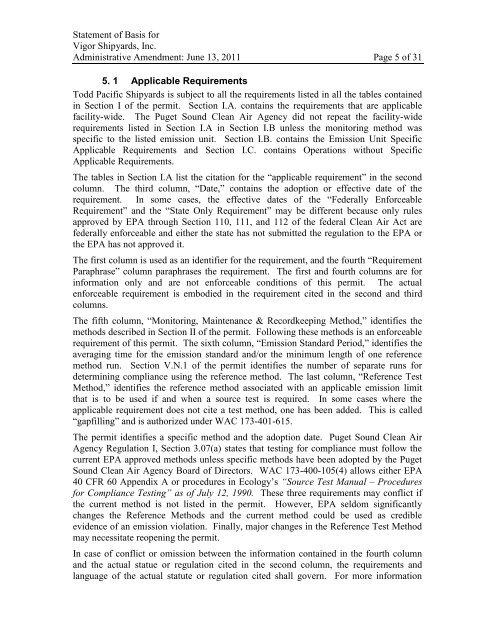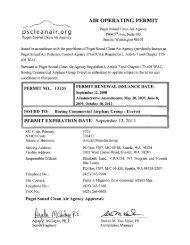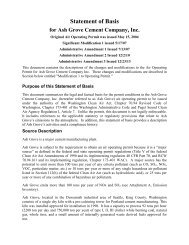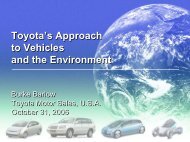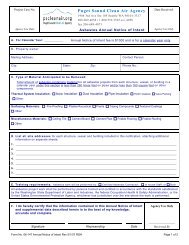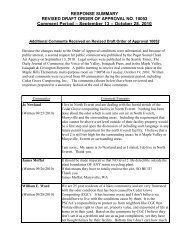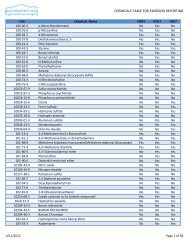Statement of Basis Vigor Shipyards Inc. - Puget Sound Clean Air ...
Statement of Basis Vigor Shipyards Inc. - Puget Sound Clean Air ...
Statement of Basis Vigor Shipyards Inc. - Puget Sound Clean Air ...
Create successful ePaper yourself
Turn your PDF publications into a flip-book with our unique Google optimized e-Paper software.
<strong>Statement</strong> <strong>of</strong> <strong>Basis</strong> for<strong>Vigor</strong> <strong>Shipyards</strong>, <strong>Inc</strong>.Administrative Amendment: June 13, 2011 Page 5 <strong>of</strong> 315. 1 Applicable RequirementsTodd Pacific <strong>Shipyards</strong> is subject to all the requirements listed in all the tables containedin Section I <strong>of</strong> the permit. Section I.A. contains the requirements that are applicablefacility-wide. The <strong>Puget</strong> <strong>Sound</strong> <strong>Clean</strong> <strong>Air</strong> Agency did not repeat the facility-widerequirements listed in Section I.A in Section I.B unless the monitoring method wasspecific to the listed emission unit. Section I.B. contains the Emission Unit SpecificApplicable Requirements and Section I.C. contains Operations without SpecificApplicable Requirements.The tables in Section I.A list the citation for the “applicable requirement” in the secondcolumn. The third column, “Date,” contains the adoption or effective date <strong>of</strong> therequirement. In some cases, the effective dates <strong>of</strong> the “Federally EnforceableRequirement” and the “State Only Requirement” may be different because only rulesapproved by EPA through Section 110, 111, and 112 <strong>of</strong> the federal <strong>Clean</strong> <strong>Air</strong> Act arefederally enforceable and either the state has not submitted the regulation to the EPA orthe EPA has not approved it.The first column is used as an identifier for the requirement, and the fourth “RequirementParaphrase” column paraphrases the requirement. The first and fourth columns are forinformation only and are not enforceable conditions <strong>of</strong> this permit. The actualenforceable requirement is embodied in the requirement cited in the second and thirdcolumns.The fifth column, “Monitoring, Maintenance & Recordkeeping Method,” identifies themethods described in Section II <strong>of</strong> the permit. Following these methods is an enforceablerequirement <strong>of</strong> this permit. The sixth column, “Emission Standard Period,” identifies theaveraging time for the emission standard and/or the minimum length <strong>of</strong> one referencemethod run. Section V.N.1 <strong>of</strong> the permit identifies the number <strong>of</strong> separate runs fordetermining compliance using the reference method. The last column, “Reference TestMethod,” identifies the reference method associated with an applicable emission limitthat is to be used if and when a source test is required. In some cases where theapplicable requirement does not cite a test method, one has been added. This is called“gapfilling” and is authorized under WAC 173-401-615.The permit identifies a specific method and the adoption date. <strong>Puget</strong> <strong>Sound</strong> <strong>Clean</strong> <strong>Air</strong>Agency Regulation I, Section 3.07(a) states that testing for compliance must follow thecurrent EPA approved methods unless specific methods have been adopted by the <strong>Puget</strong><strong>Sound</strong> <strong>Clean</strong> <strong>Air</strong> Agency Board <strong>of</strong> Directors. WAC 173-400-105(4) allows either EPA40 CFR 60 Appendix A or procedures in Ecology’s “Source Test Manual – Proceduresfor Compliance Testing” as <strong>of</strong> July 12, 1990. These three requirements may conflict ifthe current method is not listed in the permit. However, EPA seldom significantlychanges the Reference Methods and the current method could be used as credibleevidence <strong>of</strong> an emission violation. Finally, major changes in the Reference Test Methodmay necessitate reopening the permit.In case <strong>of</strong> conflict or omission between the information contained in the fourth columnand the actual statue or regulation cited in the second column, the requirements andlanguage <strong>of</strong> the actual statute or regulation cited shall govern. For more information


